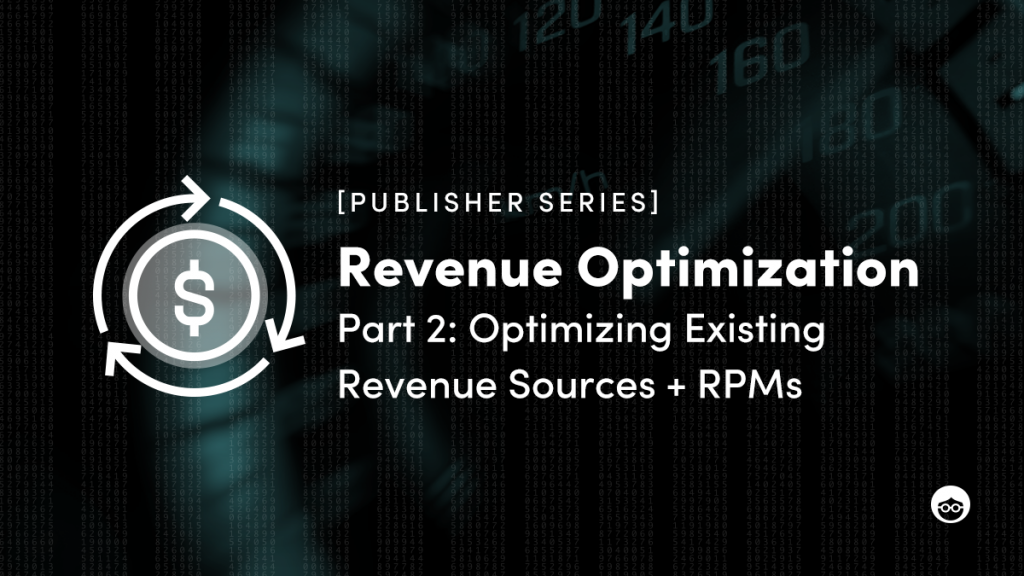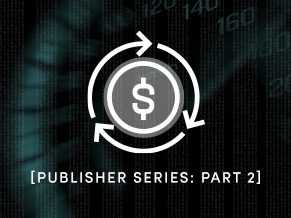[Publisher Series] Revenue Optimization, Part II: Optimizing Existing Revenue Sources + RPMs

As we’re beginning to emerge from the depths of the coronavirus pandemic, we’re now witnessing how publishers of all types and sizes have adapted.
Noted in Part I of our Revenue Optimization Series, which delved into all-things Data & Insights, the industry has seen advertising dollars collapse by over 30% per STAQ, starting in early March, causing a significant drop in publisher revenue.
Although some sites experienced extreme boosts in pageviews, partially offsetting the drop in ad rates, these pages were largely non-monetizable as Brands pulled campaigns away from topics they deemed “sensitive”, such as mentions of the global pandemic.
So the question becomes, how did successful publishers manage to preserve, and even increase, revenue during this time? And further, how could publishers learn from their strategies?
One compelling area of focus has been the optimization of revenue sources, which is largely responsible for maximizing RPMs, or Revenue Per Thousand Impressions. So in Part II, we’ll dive into helpful strategies publishers have overseen, broken down by:
- Direct Sales
- Programmatic (e.g. SSPs)
- Direct Partnerships (e.g. Native, Affiliate)
Given publishers come in all shapes and sizes, we’ll continue to provide both “basic” (i.e. short-term, quick wins) and “advanced” (i.e. complex setups) recommendations.
Onward and upward to Part II!
Part II: Optimizing Existing Revenue Sources
Basic Tactics: Short-Term (60 Days)
Revenue Source: Direct Sales
As we’ve seen, countless Brand advertisers have pulled campaigns during the crisis, particularly on pages related to COVID-19, and further to the #BlackLivesMatter movement, concerned with sensitivities. Though that didn’t stop agile Sales teams from getting creative and generating business.
Existing Advertiser Clients:
As times continue to change, the savviest of Sales teams have been seen working closely with their existing clients to appropriately change their campaigns with the times.
In some cases, publishers even offered “giveback initiatives” where they worked closely with advertisers to create the best suitable messaging for their audiences during this difficult time. These campaigns then ran at a discount or as bonus impressions on non-monetizable pages (a.k.a free!) as part of a bundle across the entire site. This approach not only generated revenue, but kept fill rates healthy across all pages.
New Advertisers:
Even despite surges in traffic, advertisers were, of course, weary in taking on new direct buys, especially given budgetary constraints for many hurt verticals.
But great Sellers saw an opportunity. As people began working from home, online audiences were searching to stock up on products and consume content related to Fitness, Health & Wellness, and PPE supplies such as facemasks. Proactively reaching out to these merchants with compelling packages, publishers were able to refocus their new business efforts to the niche, high-performers amid crisis.
By giving new advertiser clients a voice they may not otherwise have had, greater relationships were established, sure to benefit publishers and advertisers alike well beyond the pandemic.
Revenue Source: Programmatic Display and Video via SSPs
Today, almost all publishers are running some form of Programmatic demand, using one or more SSPs, or Supply Side Platforms.
Programmatic partnerships generally help fill inventory (i.e. ad units) not filled by the publisher’s own Direct Sales team. Or, can even be a publisher’s primary source of revenue. Though regardless of the setup, publishers looking for quick ways to generate revenue from Programmatic SSPs should, at a minimum, consider the following:
- Confirm ads.txt lines are up to date and maximized for efficiency.
- If you’ve traditionally used a PMP, consider opening up to more Programmatic demand sources, though know that quality can become more difficult to manage as more partnerships are brought on.
- Lower CPM floors with each demand partner to increase fill rates.
- Revisit blocks that may have been set up temporarily, as a potential conflict with your Sales team, that are now irrelevant.
- Open additional inventory to demand partners that may normally be kept exclusively for Sales or Editorial teams.
Revenue Source: Direct Partnerships
While Brand and Agency ad dollars largely pulled back during the pandemic, monetization platforms that rely more on Performance Marketers, including Affiliates, did not see as big of a drop — even seeing boosts in performance given lower competition. Some of these platforms include Media.net, Lending Tree, and, of course, Outbrain.
At Outbrain, our RPMs quickly rebounded as Performance Marketers saw that readers were still very engaged with their campaigns and offerings, and shifted strategies quickly. Essentially, demand partners that rely on a conversion to generate revenue continued to perform well.
A careful review of RPM contribution by each demand partner across various page types can (and should!) be provided to publishers, highlighting relevant data to help make quick optimizations.
One tactic was to swap non-performing sources (e.g. Direct Sales Display) from prominent positions on non-monetizable pages, with well-performing monetization partners like Affiliates to increase revenue. It’s important to note that not all Affiliates will experience performance going this route so it’s pivotal to continue reviewing results over time.
Another tactic was to backfill or replace underperforming sources — for example, Outstream Video, which is heavily reliant on brand dollars — with another high-performing demand partner. These tactics both proved that almost every ad unit on a publisher’s site can now be filled by almost any demand partner and revenue source.
Warning: Publishers should heed a warning, however, that simply inserting more ad units to an already “busy” page in order to generate short-term revenue will undoubtedly lead to a long-term revenue drop. As one publishing leader put it, “Optimizations to monetize a visit should always be balanced with a potential for users to never return.”
Advanced Approach: Medium-Term (90 to 120 Days)
Sophisticated publishers, meanwhile not only applied the Basic lessons mentioned above, but also took the opportunity to revisit monetization assumptions and rethink their long-term strategies.
In their minds, “If they were going to lose 30% in revenue, they might as well lose 40% temporarily while going through this exercise.” This way, they’d recoup the extra losses over the next six to twelve months and be better positioned for the future.
Below are a few examples from actual publishers:
1. Improve Collaboration Across Departments
Traditionally, Brand advertisers have run Display Ads on Editorial Content, while Affiliate and e-Commerce advertisers have run on Sponsored Content. While advanced publishers were already experimenting with combining Sales, Editorial, and Business Development teams, the crisis accelerated the need for more collaboration across these divisions.
As lines continue to blur between advertiser types and ad formats, Sales, Programmatic, and Business Development teams should collaborate and coordinate to maximize advertising spend.
Here’s a perfect example. As Brands began pulling campaigns, some publisher’s Direct Sales teams realized that Affiliates could be a great source of Leads for Display Ads. By approaching top-performing merchants identified from existing Affiliate relationships, the Sales team could then tailor a broader package, including Display and eCommerce links across all page types. Although typical Display Ads have very different available metrics and KPIs than Affiliates, bundling both Display and Affiliate links in one campaign meant advertisers would get more exposure cost-effectively, with more data at both the top and bottom of the funnel.
As one former Head of Sales at a major publisher put it, she would find merchants converting on her site and approach them saying “Hey, you never advertise with us, but we drive over $1M in order value a month via Affiliate links, so obviously our consumers are into your products. So, how do we form a larger partnership that includes Advertising Media, Promoted Content, Events, and Affiliate, to build a much more comprehensive strategy?”
2. Review Programmatic Bid Streams
From the Programmatic side, advanced publishers looked deeper into performance data including bid rates, response rates, bid time, winning bids, and clicks to help clean up the bid stream.
By reviewing such data, it was helpful to see that while demand partners may be bidding for an ad unit, their setup may have been too slow, causing bids to time out. In such instances, either the demand partner needs to be removed from the stack or they need to increase their response rate to ensure their bids are considered.
This Programmatic “clean up” led to higher fill rates and RPMs for publishers.
3. Shift to Header Bidders
Header Bidding — server-side, in particular — provides the best technology for publishers to maximize revenues across multiple revenue sources.
Publishers that do not yet have a Header Bidder solution should consider one immediately or risk falling further behind. Publishers that do have a solution should explore everything, leaving nothing on the table.
For example, one high-performing publisher reviewed existing SSPs and PMPs to ensure each had the best setup and partnerships, given the industry is shifting to cookieless environments and adapting new user privacy guidelines, such as CCPA and GDPR.
4. Leverage Expertise and Full Suite of a Platforms Products & Services
There’s a good chance you’re not utilizing your partnerships and platforms to the full extent of their expertise, and that’s okay, but now’s a great time to change that habit,
For example, Native Advertising platforms like Outbrain not only provide publishers with valuable demand dollars, but also, technology and expertise.
During the past few months, we’ve worked with many publishers to test various UIs, demand types (e.g. Video vs. Native), and new audience development technologies (e.g. Smartfeed, Highlight Reel, and Native In-Content) to not only drive higher revenue from Outbrain, but also to drive conversions to Subscriptions, Podcast plays, and eCommerce purchases.
Publishers should be taking this time to explore the extent of each partnership, try new features, and test multiple optimization options.
Winding Down
While many publishers made adjustments during the pandemic, to help squeeze out as much revenue as possible, best-of-breed publishers took this opportunity to rethink how they collaborate across departments, reprioritize third party revenue sources, and diversify their revenue streams to better prepare them for the future.
And now that we’ve taken a deeper look into both Data & Insights and Optimizing Revenue Sources, we’ll next explore how to optimize existing page layouts (without a redesign!).
Remember, there are still three more parts to this Revenue Optimization Series, so be sure to stay tuned:
- Live — Part 1: Reporting, Data, and Insights
- Live — Part 2: Optimizing Existing Revenue Sources + RPMs
- Coming Soon — Part 3: Optimizing Existing Page Layouts
- Coming Soon — Part 4: Optimizing Traffic Sources
- Coming Soon — Part 5: New, LTV-Driven Revenue Planning
In the meantime, consider discovering how you can manage, control, and monetize your content on the Open Web.













